Closed heating system: diagrams and features of installation of a closed type system
The main feature by which a closed heating system differs from an open one is its isolation from the influence of the environment.This scheme includes a circulation pump that stimulates the movement of the coolant. The scheme is devoid of many of the disadvantages inherent in an open heating circuit.
You will learn all about the pros and cons of closed heating schemes by reading the article we have proposed. It thoroughly examines the device options, the specifics of the assembly and operation of closed-type systems. An example of hydraulic calculation is given for independent craftsmen.
The information presented for review is based on building regulations. To optimize the perception of a difficult topic, the text is supplemented with useful diagrams, collections of photos and video tutorials.
The content of the article:
Operating principle of a closed system
Temperature expansions in a closed system are compensated by using a membrane expansion tank, filled with water during heating. When cooling, water from the tank returns to the system, thereby maintaining constant pressure in the circuit.
The pressure created in the closed heating circuit during installation is transmitted to the entire system. The circulation of the coolant is forced, so this system is energy-dependent. Without circulation pump there will be no movement of heated water through the pipes to the appliances and back to the heat generator.
Basic elements of a closed loop:
- boiler;
- air release valve;
- thermostatic valve;
- radiators;
- pipes;
- expansion tank not in contact with the atmosphere;
- balancing valve;
- ball valve;
- pump, filter;
- safety valve;
- pressure gauge;
- fittings, fasteners.
If the power supply to the house is uninterrupted, then the closed system works efficiently. Often the design is supplemented with “warm floors”, which increase its efficiency and heat transfer.
This arrangement allows you not to adhere to a certain diameter of the pipeline, reduce the cost of purchasing materials and not place the pipeline at a slope, which simplifies installation. The pump must receive liquid at a low temperature, otherwise its operation is impossible.
This option also has one negative nuance - while with a constant slope the heating works even in the absence of power supply, then with a strictly horizontal position of the pipeline the closed system does not work. This disadvantage is compensated by high efficiency and a number of positive aspects compared to other types of heating systems.
Installation is relatively simple and possible in a room of any size. There is no need to insulate the pipeline; heating occurs very quickly; if there is a thermostat in the circuit, then the temperature regime can be set. If the system is designed correctly, then there is no loss of coolant, and therefore no reason to replenish it.
The undoubted advantage of a closed-type heating system is that the temperature difference between the supply and return allows to increase the service life of the boiler. The pipeline in a closed circuit is less susceptible to corrosion. It is possible to upload to the circuit antifreeze instead of waterwhen the heating has to be turned off in winter for a long time.
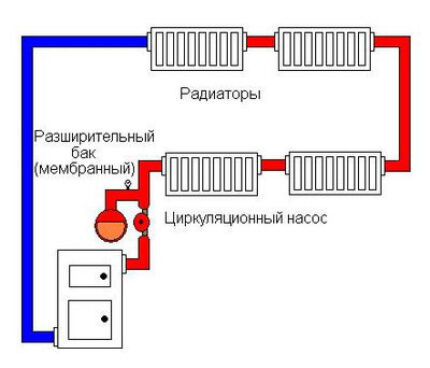
Protecting the system from air
Theoretically, air should not enter a closed heating system, but in fact it is still present there. Its accumulation is observed when pipes and batteries are filled with water. The second reason may be depressurization of joints.
As a result of the appearance of air pockets, the heat transfer of the system decreases. To combat this phenomenon, the system includes special valves and air bleed valves.

To minimize the likelihood of air pockets, certain rules must be followed when filling a closed system:
- Supply water from the bottom to the top. To do this, lay the pipes so that the water and the released air move in the same direction.
- Leave the air vent valves open and the water drain valves closed. Thus, with a gradual rise in coolant, air will escape through open air vents.
- Close the vent valve as soon as water starts flowing through it. Continue the process smoothly until the circuit is completely filled with coolant.
- Start the pump.
If in the heating circuit aluminum radiators, then air vents are required on each one.Aluminum, in contact with the coolant, provokes a chemical reaction accompanied by the release of oxygen. In partially bimetallic radiators the problem is the same, but much less air is produced.
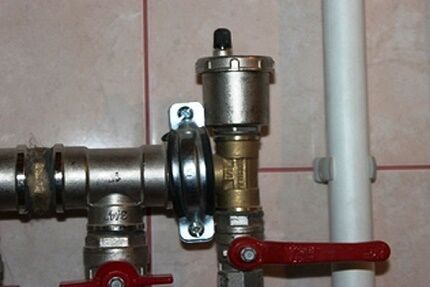
In 100% bimetallic radiators, the coolant does not come into contact with aluminum, but professionals insist on the presence of an air vent in this case too. The specific design of steel panel radiators is already equipped with air bleed valves during the production process.
On old cast iron radiators, air is removed using a ball valve; other devices are ineffective here.
Critical points in the heating circuit are pipe bends and the highest points of the system, so air exhaust devices are installed in these places. In a closed circuit it is used Mayevsky cranes or automatic float valves that allow air to be vented without human intervention.
The body of this device contains a polypropylene float connected through a rocker arm to a spool. As the float chamber fills with air, the float lowers and, upon reaching the bottom position, opens the valve through which the air escapes.
Water enters the volume freed from gas, the float rushes up and closes the spool. To prevent debris from getting inside the latter, it is covered with a protective cap.
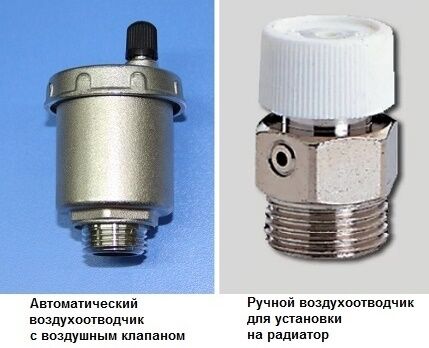
There are modifications where this process takes place differently, but the principle is the same: the float is in the lower position - gas is released; the float is raised - the valve is closed, air accumulates. The cycle repeats automatically and does not require human presence.
Read the article: 22 best automatic and manual air vents: review, quality, price.
Hydraulic calculation for a closed system
In order not to make a mistake with the selection of pipes according to the diameter and pump power, a hydraulic calculation of the system is necessary.
Effective operation of the entire system is impossible without taking into account the main 4 points:
- Determining the amount of coolant that needs to be supplied to heating devices in order to ensure a given heat balance in the house, regardless of the outside temperature.
- Maximum reduction in operating costs.
- Reducing financial investments to a minimum, depending on the selected pipeline diameter.
- Stable and silent operation of the system.
Hydraulic calculations will help solve these problems, allowing you to select the optimal pipe diameters taking into account economically justified flow rates of the coolant, determine the hydraulic pressure losses in individual sections, link and balance the branches of the system. This is a complex and time-consuming, but necessary design stage.
Rules for calculating coolant flow
Calculations are possible if a thermal engineering calculation is available and after selecting radiators by power. Thermal engineering calculations must contain reasonable data on the volume of thermal energy, loads, and heat losses.If this data is not available, then the radiator power is taken based on the area of the room, but the calculation results will be less accurate.
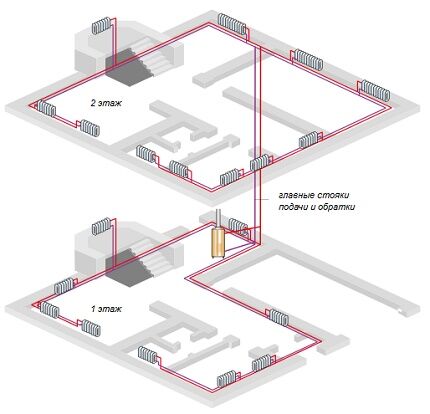
They start with a diagram. It is better to perform it in an axonometric projection and plot all the known parameters. Coolant flow is determined by the formula:
G =860q/∆t kg/h,
where q is the radiator power kW, ∆t is the temperature difference between the return and supply lines. Having determined this value, the cross-section of the pipes is determined using the Shevelev tables.
To use these tables, the calculation result must be converted into liters per second using the formula: GV = G /3600ρ. Here GV denotes the coolant flow rate in l/sec, ρ is the density of water equal to 0.983 kg/l at a temperature of 60 degrees C. From the tables you can simply select the pipe cross-section without performing a full calculation.

The calculation sequence is easier to understand using a simple diagram that includes a boiler and 10 radiators. The diagram must be divided into sections where the cross-section of the pipes and the coolant flow rate are constant values.
The first section is the line running from the boiler to the first radiator. The second is the section between the first and second radiators. The third and subsequent sections are distinguished in the same way.
The temperature from the first to the last device gradually decreases. If in the first section the thermal energy is 10 kW, then when the first radiator passes, the coolant gives it a certain amount of heat and the lost heat decreases by 1 kW, etc.
The coolant flow can be calculated using the formula:
Q=(3.6xQuch)/(сх(tr-to))
Here Qch is the thermal load of the area, c is the specific heat capacity of water, which has a constant value of 4.2 kJ/kg x s, tr is the temperature of the hot coolant at the inlet, to is the temperature of the cooled coolant at the outlet.
The optimal speed of movement of hot coolant through the pipeline is from 0.2 to 0.7 m/s. If the value is lower, air pockets will appear in the system. This parameter is affected by the material of the product and the roughness inside the pipe.
In both open and closed heating circuits, pipes made of black and stainless steel, copper, polypropylene, polyethylene of various modifications, polybutylene, etc. are used.
When the coolant velocity is within the recommended limits, 0.2-0.7 m/s, pressure losses from 45 to 280 Pa/m will be observed in the polymer pipeline, and from 48 to 480 Pa/m in steel pipes.
The internal diameter of the pipes in the section (din) is determined based on the magnitude of the heat flow and the temperature difference at the inlet and outlet (∆tco = 20 degrees C for a 2-pipe heating scheme) or coolant flow. There is a special table for this:
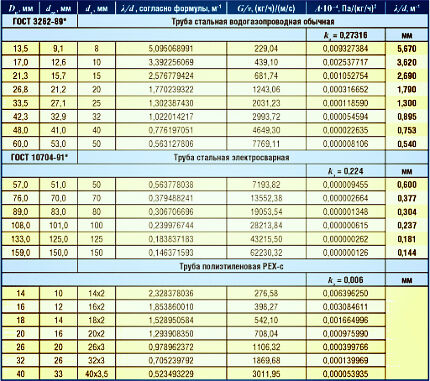
To select a circuit, you should consider one- and 2-pipe circuits separately. In the first case, the riser with the largest amount of equipment is calculated, and in the second case, the loaded circuit is calculated. The length of the site is taken from a plan drawn to scale.
Carrying out accurate hydraulic calculations can only be done by a specialist of the appropriate profile.There are special programs that allow you to perform all the calculations regarding thermal and hydraulic characteristics that can be used when heating system design for your home.
Selection of circulation pump
The purpose of the calculation is to obtain the pressure that the pump must develop to move water through the system. To do this, use the formula:
P = Rl + Z
Wherein:
- P is the pressure loss in the pipeline in Pa;
- R—specific frictional resistance in Pa/m;
- l is the length of the pipe at the design section in m;
- Z—pressure loss in “narrow” sections in Pa.
These calculations are simplified by the same Shevelev tables, from which you can find the value of friction resistance, only 1000i will have to be recalculated for a specific pipe length. So, if the inner diameter of the pipe is 15 mm, the length of the section is 5 m, and 1000i = 28.8, then Rl = 28.8 x 5/1000 = 0.144 Bar. Having found the Rl values for each section, they are summed up.
The value of pressure loss Z for both the boiler and radiators is in the passport. For other resistances, experts advise taking 20% of Rl, followed by summing the results for individual sections and multiplying by a factor of 1.3. The result will be the desired pump pressure. For single- and 2-pipe systems the calculation is the same.
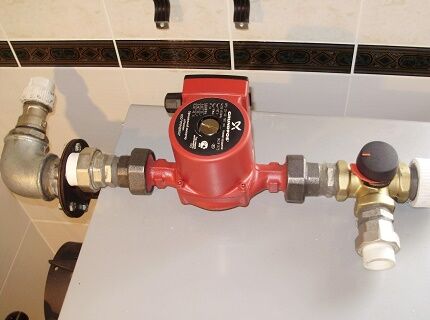
In case the pump is selected for an existing boiler, then use the formula: Q=N/(t2-t1), where N is the power of the heating unit in W, t2 and t1 are the temperature of the coolant at the outlet of the boiler and at the return, respectively.
How to calculate an expansion tank?
The calculation comes down to determining the amount by which the volume of the coolant will increase during its heating from the average room temperature of + 20 degrees C to the operating temperature - from 50 to 80 degrees. These calculations are not easy, but there is another way to solve the problem: professionals advise choosing a tank with a volume equal to 1/10 of the total amount of liquid in the system.
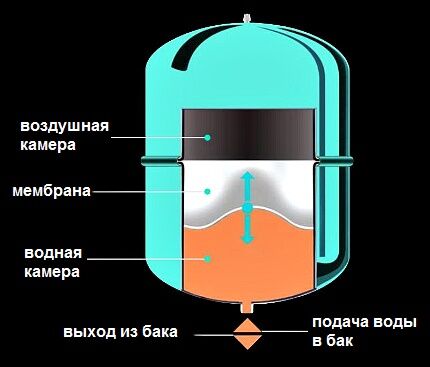
You can find out this data from the equipment passports, which indicate the capacity of the boiler water jacket and 1 radiator section. Then the cross-sectional area of pipes of different diameters is calculated and multiplied by the corresponding length.
The results are summed up, data from passports are added to them and 10% is taken from the total. If the entire system holds 200 liters of coolant, then an expansion tank with a volume of 20 liters is needed.
Tank selection criteria
Manufacture expansion tanks of steel. Inside there is a membrane dividing the container into 2 compartments. The first is filled with gas, and the second with coolant. When the temperature rises and water rushes from the system into the tank, the gas is compressed under its pressure. The coolant cannot occupy the entire volume due to the presence of gas in the tank.
The capacity of expansion tanks varies. This parameter is selected so that when the pressure in the system reaches its peak, the water does not rise above the set level. To protect the tank from overflow, a safety valve is included in the design. Normal tank filling is from 60 to 30%.

Choosing the optimal scheme
When installing heating in a private house, two types of schemes are used: one-pipe and 2-pipe. If we compare them, the latter is more effective. Their main difference is in the methods of connecting radiators to pipelines. In a two-pipe system, a mandatory element of the heating circuit is an individual riser, through which the cooled coolant returns to the boiler.
Installation of a single-pipe system is simpler and less expensive financially. The closed loop of this system combines both the supply and return pipelines.
Single pipe heating system
In one- and two-story houses with a small area, the scheme of a single-pipe closed-type heating circuit has proven itself well, which consists of a wiring of 1 pipe and a number of radiators connected to it in series.
She is sometimes popularly called “Leningradka”. The coolant, giving off heat to the radiator, returns to the supply pipe and then passes through the next battery. The last radiators receive less heat.
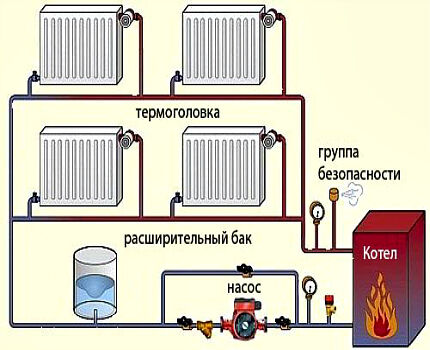
The advantage of this scheme is economical installation - it takes less material and time than a 2-pipe system. If one radiator fails, the rest will operate normally when using a bypass.
The capabilities of a single-pipe circuit are limited - it cannot be started in stages, the radiators heat up unevenly, so sections must be added to the last one in the chain. To prevent the coolant from cooling so quickly, it is necessary to increase the diameter of the pipes. It is recommended to connect no more than 5 radiators for each floor.
There are 2 types of systems: horizontal and vertical. In a one-story building, the horizontal heating system is installed both above and below the floor. It is recommended to install the batteries at the same level, and the horizontal supply pipeline at a slight slope in the direction of flow of the coolant.
With vertical distribution, water from the boiler rises up the central riser, enters the pipeline, is distributed over separate risers, and from them - through radiators. Cooling, the liquid falls down the same riser, passing through all the devices there, ending up in the return pipeline, and from there the pump pumps it back to the boiler.
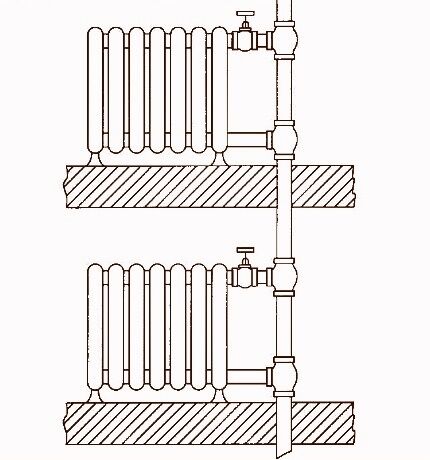
Having chosen a closed type of heating system, installation is performed in the following sequence:
- Install the boiler. Most often, a place is allocated for it on the ground or first floor of the house.
- Pipes are connected to the inlet and outlet pipes of the boiler and routed around the perimeter of all rooms. Connections are selected depending on the material of the main pipes.
- Install the expansion tank, placing it at the highest point. At the same time, a safety group is installed, connecting it to the main line through a tee. Fix the vertical main riser and connect it to the tank.
- They are installing radiators with the installation of Mayevsky taps. The best option: bypass and 2 shut-off valves - one at the inlet, the other at the outlet.
- Install the pump in the area where the cooled coolant enters the boiler, having previously installed a filter in front of its installation site. The rotor is positioned strictly horizontally.
Some craftsmen install a pump with a bypass so as not to drain water from the system in case of repair or replacement of equipment.
After installing all the elements, open the valve, fill the line with coolant, and remove the air. Check that the air has been completely removed by unscrewing the screw located on the pump housing cover. If liquid comes out from under it, it means that the equipment can be started by first tightening the previously unscrewed central screw.
With practice-tested schemes single-pipe heating systems and device options you can find in another article on our website.
Two-pipe heating system
As in the case of a single-pipe system, there is horizontal and vertical wiring, but here there is both a supply and a return line. All radiators heat up equally. One type differs from another in that in the first case there is a single riser and all heating devices are connected to it.

The vertical scheme involves connecting radiators to a riser located vertically. Its advantage is that in a multi-storey building, each floor is connected to the riser individually.
A special feature of the two-pipe scheme is the presence of pipes connected to each battery: one direct-flow and the other return. There are 2 diagrams for connecting heating devices. One of them is a collector type, when 2 pipes go from the collectors to the battery.
The scheme is characterized by complex installation and high consumption of material, but the temperature in each room can be adjusted.
The second is a simpler parallel circuit. The risers are installed around the perimeter of the house, and radiators are connected to them. There is a sun lounger running along the entire floor and risers are connected to it.
The components of such a system are:
- boiler;
- safety valve;
- pressure gauge;
- automatic air vent;
- thermostatic valve;
- batteries;
- pump;
- filter;
- balancing device;
- tank;
- valve.
Before proceeding with installation, the issue of the type of energy carrier should be resolved. Next, install the boiler in a separate boiler room or in the basement.The main thing is that there is good ventilation there. Install a collector, if provided for by the project, and a pump. Adjustment and measuring equipment is installed next to the boiler.
A line is connected to each future radiator, then the batteries themselves are installed. Heating devices are hung on special brackets in such a way that there are 10-12 centimeters left to the floor, and 2-5 cm from the walls. The openings of the devices at the inlet and outlet are equipped with shut-off and control devices.

After installation of all components of the system, it is pressurized. This should be done by professionals because only they can issue the appropriate document.
Details of the design of a two-pipe heating system described here, the article presents various schemes and their analysis.
Conclusions and useful video on the topic
This video material presents an example of a detailed hydraulic calculation of a 2-pipe closed-type heating system for a 2-story house in the VALTEC.PRG program:
Here is a detailed description of the design of a single-pipe heating system:
It is possible to install a closed version of the heating system yourself, but you cannot do it without consulting specialists. The key to success is a properly completed project and quality materials.
Do you have any questions about the specifics of a closed heating circuit? Is there information on the topic that would be of interest to site visitors and us? Please write comments in the block below.

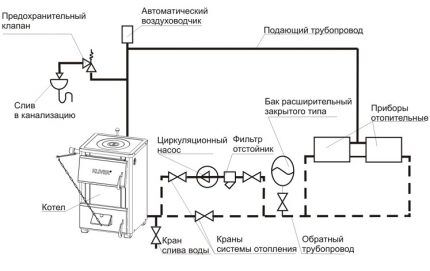




But it is not suitable for every type of home, this is also worth considering. The system, of course, is extremely effective, but try installing it in houses that are already “eleven” years old, and they are simply even planned for a different heating network. It is worth considering that this option is only suitable for modern buildings, in which even the very design of the house was originally intended to be so. Although I don’t rule out that I could be wrong, I wouldn’t risk it in old houses.
There is no risk in old houses, but it is still advisable to redo the entire system, including pipes and radiators. For example, when replacing a boiler. Actually, modern wall-mounted boilers already come with built-in pumps and expansion tanks. So, all that remains is to change the pipes and preferably the radiators. Better yet, install heated floors. The gain will be in both design and efficiency.